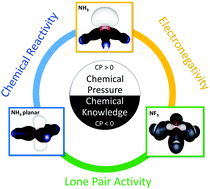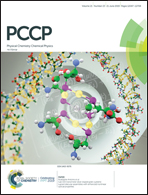Chemical pressure–chemical knowledge: squeezing bonds and lone pairs within the valence shell electron pair repulsion model†
Abstract
The valence shell electron pair repulsion (VSEPR) model is a demanding testbed for modern chemical bonding formalisms. The challenge consists in providing reliable quantum mechanical interpretations of how chemical concepts such as bonds, lone pairs, electronegativity, or hypervalence influence (or modulate) molecular geometries. Several schemes have been developed thus far to visualize and characterize these effects; however, to the best of our knowledge, no scheme has yet incorporated the analysis of the premises derived from the ligand close-packing (LCP) extension of the VSEPR model. Within the LCP framework, the activity of the lone pairs of the central atom and ligand–ligand repulsions constitute the two key features necessary to explain certain controversial molecular geometries that do not conform to the VSEPR rules. Considering the dynamical picture obtained when electron local forces at different nuclear configurations are evaluated from first-principles calculations, we investigate the chemical pressure distributions in a variety of molecular systems, namely, electron-deficient molecules (BeH2, BH3, BF3), several AX3 series (A: N, P, As; X: H, F, Cl), SO2, ethylene, SF4, ClF3, XeF2, and nonequilibrium configurations of water and ammonia. Our chemical pressure maps clearly reveal space regions that are totally consistent with the molecular and electronic geometries predicted by VSEPR and provide a quantitative correlation between the lone pair activity of the central atom and electronegativity of ligands, which are in agreement with the LCP model. Moreover, the analysis of the kinetic and potential energy contributions to the chemical pressure allows us to provide simple explanations on the connection between ligand electronegativity and electrophilic/nucleophilic character of the molecules, with interesting implications in their potential reactivity. NH3, NF3, SO2, BF3, and the inversion barrier of AX3 molecules are selected to illustrate our findings.



 Please wait while we load your content...
Please wait while we load your content...